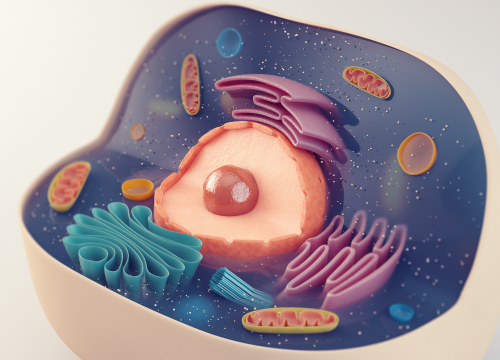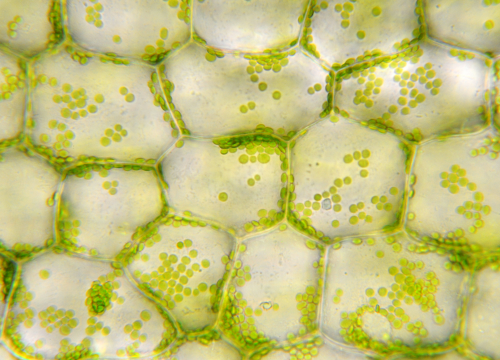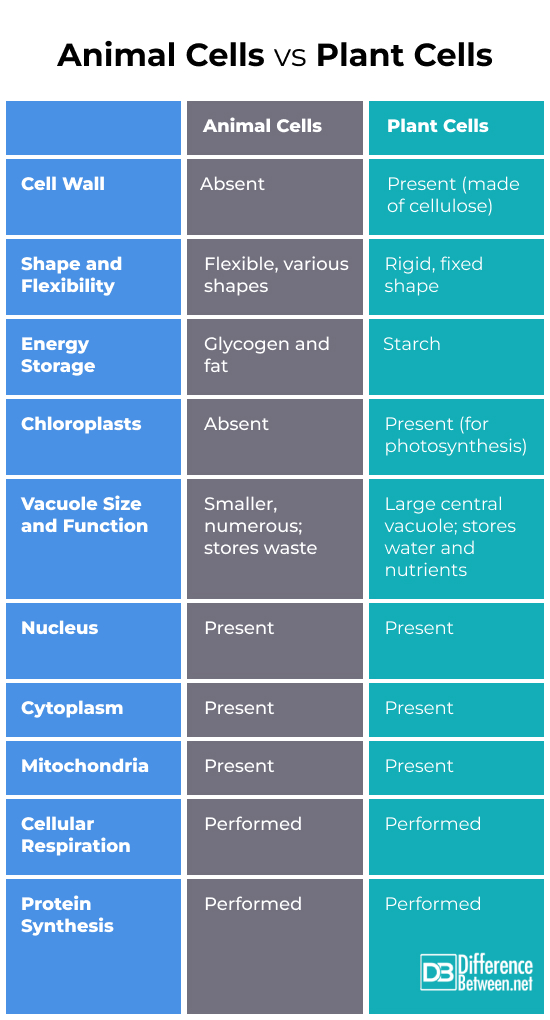Difference Between Animal and Plant Cells
Introduction
What sets your heart beating and brings the world to life in shades of green? It all comes down to cells, the basic units of life. Picture them as tiny, vibrant cities, each with its own rules and roles. More than just biological bricks, cells contribute to life’s diversity. Like threads in life’s tapestry, animal and plant cells weave their unique patterns. Why bother about the differences? It’s fascinating how a leaf cell can use solar energy, while an animal cell can’t. From advancing drug development to paving the way for future energy generation, these microscopic marvels hold the keys. Shall we begin this small journey?

What are Animal Cells?
The Basic Unit of Animal Life
Ever wondered about the cat purring on your lap or the butterfly fluttering by? Animal cells—tiny yet complex—shape them. Animal cells are like bustling cities with flexible boundaries, changing shape as needed, unlike plant cells. These addressless cells make up every animal kingdom member, from insects to whales.
Key Components and their Functions
So, what happens in these tiny cities? DNA, the blueprint of life, resides in the nucleus, the command center. City hall dictates what happens and when. Organelles work in the cytoplasm, surrounding the nucleus. Like power stations, mitochondria convert food into energy. Lysosomes clear up trash. In there, a vast world of parts is vital to the cell and animal’s survival.
Where they are found
These cells exist where? Animals’ entire bodies. From your skin to your muscles, animal cells labor constantly, undetected. Your cat’s purr, a dog’s wagging tail, a bird’s song—they are life in motion.

What are Plant Cells?
Understanding Plant Cells: Fundamentals
Plant cells, stiff, make up all plant life. Consider them mini-factories with robust cell walls. From the massive oak to the delicate rose petal, this rigidity gives plants their structure.
Key Components and their Functions
The nucleus, the genetic blueprint mastermind, is in the plant cell. The cytoplasm, where cell activities occur, surrounds it. Photosynthesis in chloroplasts—nature’s solar panels—is unique to plant cells. The big vacuole stores nutrients and maintains cell pressure. Each part is vital, organizing life-sustaining activities.
Where they are found
Find these little powerhouses where? Throughout plant life! Leaves ruffle in the breeze, fruits tickle your taste buds, and roots anchor plants to the ground. Every breath and veggie mouthful contains plant cells. Nature’s silent but vital architects.
Similarities Between Animal and Plant Cells
Common Cell Functions and Structures
Although they are different, animal and plant cells have some similarities.
- Both types have a nucleus, which contains the DNA, the life blueprint.
- A plasma membrane which is a selective barrier regulating what enters and exits the cell.
- Cytoplasm is a lively marketplace for cell activities.
- Also, mitochondria, the cell’s power factory that converts nutrients into energy in both cell types.
Shared Cellular Processes
Animal and plant cells share basic activities beyond structures.
- Both undergo cellular respiration, which converts glucose into energy.
- They both synthesize proteins, which is produces by ribosomes for cell function and growth.
- Following the universal code of life in their DNA, both types of cells replicate and act on their genetic material.
These common mechanisms demonstrate how animal and plant cells, however unique, are part of the same biological symphony.
Differences Between Animal and Plant Cells
Cell walls presence
The cell wall is a big difference. Polysaccharide cell walls give plant cells shape and support. It is like armor that protects and shapes the cell. Animal cells do not have this stiff wall, so they can bend and change shape more easily.
Photosynthesis and chloroplasts
Chloroplasts are very important to plant cells because they turn light into energy. Plant cells can grow food using only sunlight because of their unique green structure. Because animal cells do not have chloroplasts, they can not do photosynthesis and must get their energy from food.
How Big and What Vacuole Does
Vacuoles are very different in each cell. Plant cells have a big space in the middle that holds water and nutrients and controls the pressure inside the cell. Vacuoles in animal cells are smaller and there are more of them. They store waste and other stuff.
Shape and Flexibility
Whether these cells have a cell wall or not changes their shape and how flexible they are. Plant cells are stiff and can not bend, but animal cells are soft and can.
Energy Storage
Lastly, these cells store energy in a different way. Starch, a type of complex protein, is how plant cells store energy. Animal cells, on the other hand, store energy as fat and glucose.
Animal Cells vs Plant Cells

Summary
What significance does the difference between plant and animal cells have, then? Actually, quite a bit. These minute variations create a vast image. Plant cells, with their protective walls and chloroplasts that absorb sunlight? They are the natural power plants. Furthermore, every breath and every heartbeat are powered by animal cells—those pliable little fellas. This is the blueprint for life itself, not just some science fiction.
The best part? These minute cellular details are extremely significant. They make us more knowledgeable about everything from combating harmful illnesses to raising superior crops. It is similar to discovering nature’s mysteries one cell at a time. Who would have thought something so tiny could be so enormous?
FAQs
What are similarities between plant and animal cells?
Both plant and animal cells are like tiny factories with a lot going on. They’ve got a nucleus, where all the DNA action happens. They’re wrapped up in a plasma membrane, kinda like a security gate. Inside, they’ve got mitochondria (think of tiny power stations) and a bunch of other shared bits and bobs that keep things running smooth.
What is found in plant cells only?
Plant cells have their exclusive club features: a sturdy cell wall (think of a plant’s personal armor), chloroplasts (for turning sunlight into food – pretty cool, right?), and a big vacuole for storing water and stuff.
What do plant cells have that animal cells do not?
Plant cells rock a cell wall, chloroplasts (hello, photosynthesis!), and a big central vacuole – stuff you won’t find in animal cells. It’s like they have their own special toolkit for living the plant life.
Do plant cells have DNA?
Yep, plant cells have DNA, just chilling in the nucleus. It’s like the master plan for the plant, telling it how to grow, survive, and do all its plant-y things.
Are plants unicellular or multicellular?
Most plants you see – trees, flowers, you name it – are multicellular, made up of loads of cells. But hey, there are also some unicellular plants, like algae, doing their thing solo.
What are the 13 parts of a plant cell?
Buckle up, here’s the roll call: 1) Cell Wall, 2) Cell Membrane, 3) Cytoplasm, 4) Nucleus, 5) Mitochondria, 6) Chloroplasts, 7) Vacuole, 8) Endoplasmic Reticulum, 9) Golgi Apparatus, 10) Ribosomes, 11) Lysosomes (in some plant cells), 12) Peroxisomes, and 13) Plasmodesmata. Each part’s got a job, making sure the cell stays on top of its game.
- Difference Between Suicide and Euthanasia - May 22, 2024
- Difference Between Vitamin D and Vitamin D3 - May 21, 2024
- Difference Between Running Shoes and Walking Shoes - April 30, 2024
Search DifferenceBetween.net :
95 Comments
Trackbacks
- Difference Between Prokaryotes and Eukaryotes | Difference Between
- Difference between the Food Chain and the Food Web | Difference Between
- Difference Between DNA and Genes | Difference Between
- Difference Between Dysentery and Diarrhea | Difference Between | Dysentery vs Diarrhea
- Difference Between Benign and Malignant | Difference Between | Benign vs Malignant
Leave a Response
References :
[0]Gunning, B. E., & Steer, M. W. (1996). Plant cell biology: structure and function. Jones & Bartlett Learning.
[1]Threadgold, L. T. (2017). The ultrastructure of the animal cell: international series in pure and applied biology (Vol. 55). Elsevier.
[2]1 Gunning, B. E., & Steer, M. W. (1996). Plant cell biology: structure and function. Jones & Bartlett Learning.
[3]2 Gunning, B. E., & Steer, M. W. (1996). Plant cell biology: structure and function. Jones & Bartlett Learning.
[4]3 Gunning, B. E., & Steer, M. W. (1996). Plant cell biology: structure and function. Jones & Bartlett Learning.
[5]Image credit: https://www.canva.com/photos/MAEI3cEyBNo-green-chloroplasts-in-plant-cells/
[6]Image credit: https://www.canva.com/photos/MADermt8S_w-anatomical-structure-of-animal-cell/

Great article! Here’s a video that goes into more depth on the differences between plant and animal cells: http://blog.thinkwell.com/2009/06/thinkwell-biology-plant-and-animal-cell-overview.html
@Hank,
Thank you for sharing the video.
i did not get it yet
this is the most awesomest website ever help me out big time i sooo own this test tommorw this was hard to understand untill someone help me it was so long but this website is wroth it because i really need the extra credit that way i could get a A+ in science and get my phone back from my day
hahaha you all fail hurry up and revise losers
great website
great job guys!
thanks for helping me with my pop science project!
thanszzzzzzzzzzzzzzzz for helping me doing my project
its ok
Ok umm hi annnd thankz…..
first i would like to say thank you for your research. These informations are realy important. Thats blank point but i need to write date. I mean when is it written? Who had written?
again thx. have a good work
Heey thanks for this awsomeeeee weebsite(:
itt heelped me soo much with myyy asciencee profject!
i thhink it is waay better then that .. google crapp !
orr yahoo stuff(;<3
thankkss again!!!!!!
hi i think this website gives great information.
cool im so happy
thanks for the help
now i can write my lab report
thx alot
thank u guys so so so much u guys made me get my xbox 360 and raw vs smackdown ft ecw 2010 edition thank u guys.
I like this site because it gives me specific information, most importantly it is posted simply like a short trivia and information.
thanks lanceaksh , it is really very useful . it helped me alot in my assignment and made my work more easier.
wellllllllllllllllllllllcommmmmmmmm
Thnax 4 helping mi with mi science project!!!!!
thanks now my report is done. this really helped alot
dude i needed to do a project on this!!!!!!!this helped me so much ♥!!!
cool i need it for elementry school haha and i really dont get cells thx for this website i got a 120 on my paper cause of the info and the coloring the info was not on the book it rasied my grade my last test i got a 63 O: so now i got a 100 in science 🙂
Very interesting…….
This website is very useful for a student
diz iz a great website cuz in class 2day my teacher wuz sayin things bout cells so diz gives u alot of info
Pls can i read dis site for exam or i need to get some textbook to support it. Pls reply.
Thank God for the internet. I had a sick day and missed a whole lesson on plant/animal cells, and now I’m caught up with the rest of the class, more or less.
…
DRUM SOLO!!!
YYYYYYYEEEEEEEEEEEEEAAAAAAAAAHHHHHHHHHHHHHHHHHH!!!!!!!!!!
hiiiiiiii allll this web site contain all diffrences i like tis web site
i liked this…..it helped in my assignment…….thanks 🙂 ……
i love this sight
thank you
this is helpful.. thanks a lot! 🙂
This helpedme on answering my reviewers! Thanks to this! 😀
This helped me on answering my reviewers! Thanks to this! 😀
can somebody help me wit my six page report
yes
it is great website hats of boss
nice!! thanks for sharing ^_^
guy’s i need you help about my project!!!!about the part of animals and plants cells.
THANKS A LOT,,,,,!!!!!!!!!!
wow!!
i got so much help frm this site!!!!
well it didnt have one thing i was looking for sure but other than that it was a great website…♥
Thank You ! Thank You ! Thank You !
Awsome job i love it it helped me make flash cards to study for my science test 😀
♥♥♥♥♥♥♥♥♥♥♥♥♥
Helped Me With My Assignment 🙂
Thanks this website has helped me very much. i really like it..
Thanks for heleping me with my assignment
can anyone help me cite this. huge help for my report thanks!
Thanks very much =)
Very helpful thanks very much
OH MY GOSH. You have just done my home work for me THANK YOU:)X
this website is really good this web help me so much for my exam
Thanks for the valuable information, now i’ll be able to complete my lab report.
this helped me alot in my science class !!!!!!!!!
I think it is worthy to point out some more information, like:
“the plant cells use linking pores in their cell wall to connect to each other and pass information” <– What do we call them?
And there's something that's not totally correct. It is not incorrect, but it may lead people into mistake. When you say that plants cell turn carbon dioxide into sugar, and that animal cells break the sugar back down to carbon dioxide, to make energy, one that knows absolutelly nothing about this may think that plant cells don't break sugar, to make energy. They also do it.
Don't misunderstand me ^^, I'm not a hater, I just like to see things clear.
this site is mad i love it so much i got a A+ on my project 🙂 thankyou so much im so happy
call me for a good time
now,i have a idea for the different of plants and animal cell
Thanks…this website help alot…..THANK YOU
TNX FOR THE INFORMATION
Both plant and animal cells are eukaryotic cells, i.e., they have complex structures but the structures of both types of cells have major differences.
Animal cells do not have rigid cell walls like plant cells. This allows animal cells to form and adopt various shapes. A type of animal cell called the phagocytic cell can even absorb other structures. This ability is not inherent in plant cells.
😀
thanks for this website.. now im ready for the report tomorow… thank you!
nice blog. I found it useful for students
Thanks! you helped me in my science homework
very usefull for studing
i liked it soooooooooooooooooooooooooooooooooooooooo much!
NICE
Hhahah dude that halarouis you r funny!!!!!
lllllllllllllllllllllllllllllllooooooooooooooooooooooooooooooollllllllllllllllllllllllllll are there any more differences that you can state????
screwith youith
Screw you!
good site
what about lysosomes
Too sciency